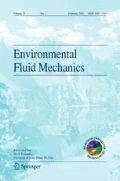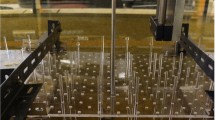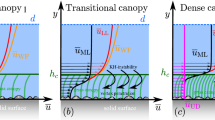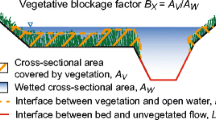Abstract
Analyses of results from laboratory flume experiments are presented in which flow within gaps in canopies of flexible, submerged aquatic vegetation simulations is investigated. The aims of the work are (a) to identify the different flow regimes that may be found within such gaps, using Morris’ classical definitions of skimming flow, wake interference flow and isolated roughness flow as a template, (b) to determine the parameter space in which those flow regimes are most consistently delineated, and (c) to provide quantitative measurements of the loci of each flow regime within that parameter space for these experiments. The sedimentary and biological implications of each flow regime are also discussed. The results show that five flow regimes may be identified, expanding on Morris’ original set of three. The five are: (i) skimming flow; (ii) recirculation flow; (iii) boundary layer recovery; (iv) canopy through-flow; and (v) isolated roughness flow, the last being assumed to occur in some cases though it is not directly observed in these experiments. A Reynolds number based on the canopy overflow speed and the gap depth, and the gap aspect ratio are found to be the key parameters that determine these flow regimes, though a Froude number is found to be important for determining bed shear stress, and the length of leaves overhanging the gap from the upstream canopy is found to be important in determining the location of flow recirculation cells within the gap.
Similar content being viewed by others
References
Abdelrhman MA (2003) Effect of eelgrass Zostera marina canopies on flow and transport. Mar Ecol Prog Ser 248: 67–83. doi:10.3354/meps248067
Arcement GJ, Schneider VR (1989) Guide for selecting Manning’s roughness coefficients for natural channels and flood plains. United States Geological Survey Water Supply Paper 2339. US Government, Washington
Barbera-Cebrian C, Sanchez-Jerez P, Ramos-Espla AA (2002) Fragmented seagrass habitats on the Mediterranean coast, and distribution and abundance of mysids. Mar Biol 141: 405–413. doi:10.1007/s00227-002-0852-3
Best J (2005) The fluid dynamics of river dunes: a review and some future research directions. J Geophys Res (Earth Surf) 110(F4) art. no. F04S02. doi:10.1029/2004JF000218
Bologna PAX, Heck KL (2002) Impact of habitat edges on density and secondary production of seagrass-associated fauna. Estuaries 25: 1033–1044
Cassiani M, Katul GG, Albertson JD (2008) The effects of canopy leaf area index on airflow across forest edges: large-eddy simulation and analytical results. Bound Layer Meteorol 126: 433–460
Davis JA, Barmuta LA (1989) An ecologically useful classification of mean and near-bed flows in streams and rivers. Freshw Biol 21: 271–282. doi:10.1002/esp.520
Folkard AM (2005) Hydrodynamics of model Posidonia oceanica patches in shallow water. Limnol Oceanogr 50: 1592–1600
Folkard AM (2010) Vegetated flows in their environmental context: a review. Proc Inst Civ Eng—Eng Comput Mech (in press)
Folkard AM, Gascoigne JC (2009) Hydrodynamics of discontinuous mussel beds: laboratory flume simulations. J Sea Res 62: 250–257
Fonseca MS, Fisher JS, Zieman JC, Thayer GW (1982) Influence of the seagrass Zostera marina L. on current flow. Estuar Coast Shelf Sci 15: 351–364
Fonseca MS, Koehl MAR, Kopp BS (2007) Biomechanical factors contributing to self-organization in seagrass landscapes. J Exp Mar Biol Ecol 340: 227–246. doi:10.1016/j.jembe.2006.09.015
Gacia E, Duarte CM (2001) Sediment retention by a Mediterranean Posidonia oceanica meadow: the balance between deposition and resuspension. Estuar Coast Shelf Sci 52: 505–514
Gambi MC, Nowell ARM, Jumars PA (1990) Flume observations of flow dynamics in Zostera marina (eelgrass) beds. Mar Ecol Prog Ser 61: 159–169
Ghisalberti M, Nepf H (2006) The structure of the shear layer in flows over rigid and flexible canopies. Environ Fluid Mech 6: 277–301
Granata TC, Serra T, Colomer J, Casamitjana X, Duarte CM, Gacia E (2001) Flow and particle distributions in a nearshore seagrass meadow before and after a storm. Mar Ecol Prog Ser 218: 95–106
Green MO, Hewitt JE, Thrush SF (1998) Seabed drag coefficient over natural beds of horse mussels (Atrina zelandica). J Mar Res 56: 613–637
Jovic S, Driver M (1994) Backward-facing step measurements at low Reynolds number, Re h = 5000. NASA Technical Memo, TM-108807. NASA, Moffett Field
Kaimal J, Finnigan J (1994) Atmospheric boundary layer flows. Oxford University Press, Oxford
Lane SN et al (1998) Three-dimensional measurement of river channel flow processes using acoustic Doppler velocimetry. Earth Surf Proc Landf 23: 1247–1267
Le H, Moin P, Kim J (1997) Direct numerical simulation of turbulent flow over a backward-facing step. J Fluid Mech 330: 349–374
Lightbody A, Nepf HM (2006) Prediction of velocity profiles and longitudinal dispersion in emergent salt marsh vegetation. Limnol Oceanogr 51: 218–228
Luhar M, Rominger J, Nepf HM (2008) Interaction between flow, transport and vegetation spatial structure. Environ Fluid Mech 8: 423–439. doi:10.1007/s10652-008-9080-9
Maltese A, Cox E, Folkard AM, Ciraolo G, La Loggia G, Lombardo G (2007) Laboratory measurements of flow and turbulence in discontinuous distributions of ligulate seagrass. J Hydraul Eng-ASCE 133: 750–760. doi:10.1061/(ASCE)0733-9429(2007)133:7(750)
Markfort CD, Perez ALS, Thill JW, Jaster DA, Porté-Agel F, Stefan HG (2010) Wind sheltering of a lake by a tree canopy or bluff topography. Water Resour Res 46: W03530
Morris HM (1955) A new concept of flow in rough conduits. Trans Am Soc Civ Eng 120: 373–398
Nepf HM (1999) Drag, turbulence, and diffusion in flow through emergent vegetation. Water Resour Res 35: 479–489
Nepf HM, Vivoni E (2000) Flow structure in depth-limited, vegetated flow. J Geophys Res 105(C12): 28547–28557
Nowell ARM, Church M (1979) Turbulent-flow in a depth-limited boundary-layer. J Geophys Res (Oceans Atmos) 84(NC8): 4816–4824
Nowell ARM, Jumars PA (1984) Flow environments of aquatic benthos. Annu Rev Ecol Syst 15: 303–328
Oke TR (1988) Street design and urban canopy layer climate. Energy Build 11: 103–113
Serra T, Fernando HJS, Rodriguez RV (2004) Effects of emergent vegetation on lateral diffusion in wetlands. Water Res 38: 139–147. doi:10.1016/j.watres.2003.09.009
Walker IJ, Nickling WG (2003) Simulation and measurement of surface shear stress over isolated and closely spaced transverse dunes in a wind tunnel. Earth Surf Process Landf 28: 1111–1124
Wilson CAME (2007) Flow resistance models for flexible submerged vegetation. J Hydrol 342: 213–222. doi:10.1016/j.jhydrol.2007.04.022
Wilson CAME, Stoesser T, Bates PD, Pinzen AB (2003) Open channel flow through different forms of submerged flexible vegetation. J Hydraul Eng-ASCE 129: 847–853. doi:10.1061/(ASCE)0733-9429(2003)129:11(847)
Wu F-C, Shen HW, Chou Y-J (1999) Variation of roughness coefficients for unsubmerged and submerged vegetation. J Hydraul Eng-ASCE 125: 934–942
Yager PL, Nowell ARM, Jumars PA (1993) Enhanced deposition to pits—a local food source for benthos. J Mar Res 51: 209–236
Young WJ (1992) Clarification of the criteria used to identify near-bed flow regimes. Freshw Biol 28: 383–391
Author information
Authors and Affiliations
Corresponding author
Rights and permissions
About this article
Cite this article
Folkard, A.M. Flow regimes in gaps within stands of flexible vegetation: laboratory flume simulations. Environ Fluid Mech 11, 289–306 (2011). https://doi.org/10.1007/s10652-010-9197-5
Received:
Accepted:
Published:
Issue Date:
DOI: https://doi.org/10.1007/s10652-010-9197-5




